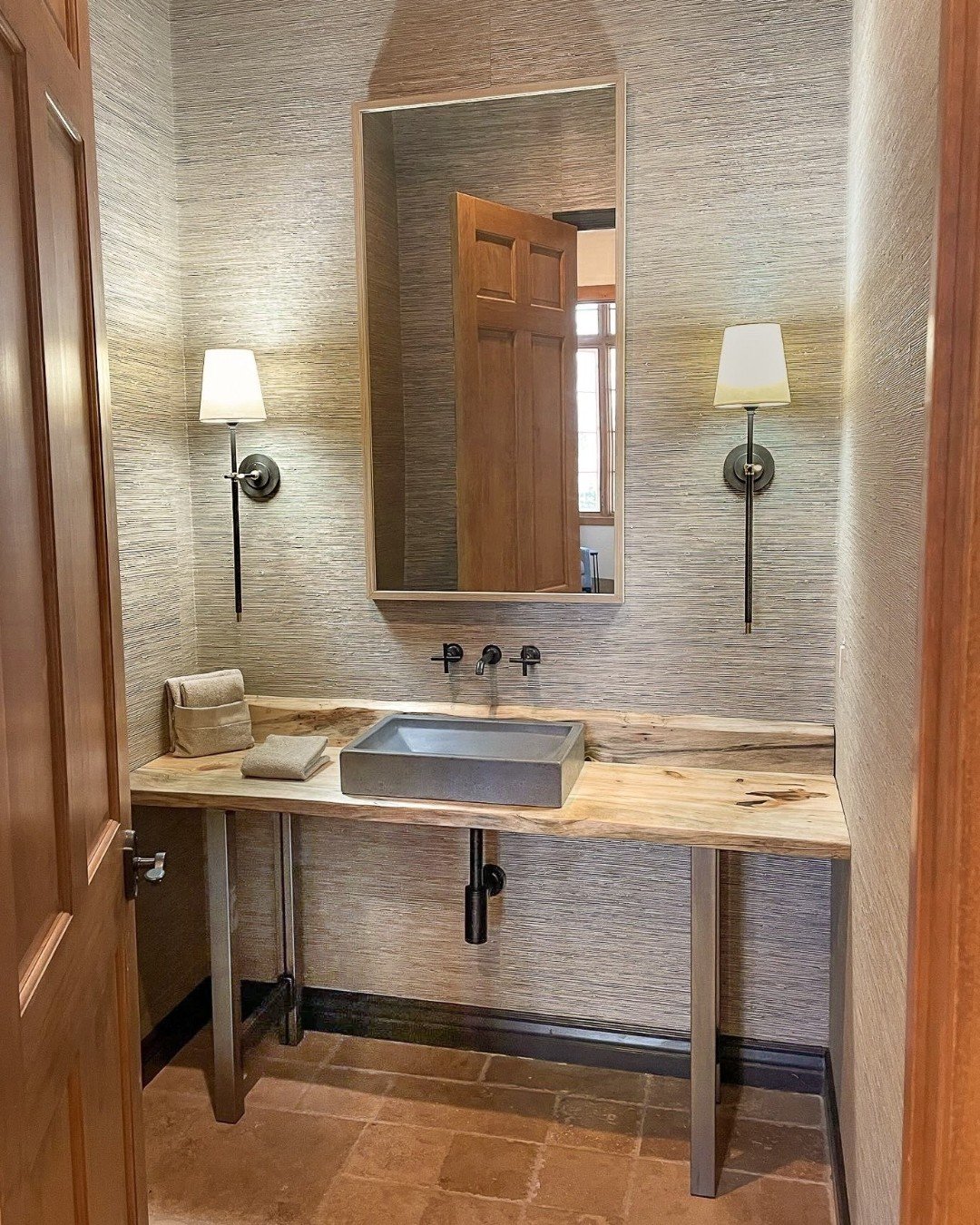Todd Talks Bathrooms. Over the past few years, the idea of the bathroom as a place of refuge and rest has been slowly gaining in popularity. This year, however, the idea has officially taken root and word is spreading quickly. What once was seen as a utilitarian space is now seen as a luxurious transformative space. This shift in thought has brought a shift in product expectation levels and bathroom design as well. Bathrooms are now viewed as rooms offering relaxation and renewal. The profile of all types of luxury products for the bath, especially hard surfaces, has been raised. In addition to the high performance standards already expected, clients have also raised their standards for the aesthetic contribution of hard surface products.
While the shift in thinking has been transformative, it hasn’t changed our overall approach to bath design. However, it has reinforced the importance and complexity of hard surface decisions. This is not new information for anyone who has gone through the process, but it is nice to hear. These decisions become the foundation upon which every other decision will be built. The importance of devoting adequate time and resources to this part of any building project assures your hard surface decisions have the greatest chance of success.
When working with clients, we begin the conversation about bathroom hard surfaces early in the design process. As preliminary choices are made, we use solid design principles and develop schemes to help clients see their choices in action. This process creates great results with confident clients. No pitfalls here, just solid decision making.
However, if a pitfall does occur, navigating around it effectively is most helpful. Doing so can protect your frame of mind and keep the project moving forward. Here are some tips for navigating through pitfalls with ease:
Take your time. Give yourself permission to take your time. This is the most important piece of advice. Work through the process with due diligence, but be patient with yourself along the way.
Don’t Sacrifice. Don’t make a quick decision to make an issue go away. That never works. You will end up dealing with the same issue again because it will continue to arise until it is fixed in the way you believe is best
Don’t make “spur of the minute” decisions. Don’t make a decision simply because it is easier, less expensive, or can be resolved immediately. Make the correct decision, not the fast one.
Shower Storage. We all need storage for everyday items in the shower. But, our golden rule is to remember the shower is a shower. The shower is not a storage closet. Only keep essential items in the shower…the fewer the better. The best options for storage are not concealed. Therefore, everything can be easily seen. The idea is to create an understated, yet convenient, place to keep essential items without detracting from the overall shower design.
There are generally two storage options to consider: a recessed niche or shower shelf. The idea of recessing a niche into the wall for storage is a great one. The niche helps organize items and the recessed placement suggests it is not the focal point. While the shower shelf does keep the products in view, it also provides a more modern approach to the shower storage dilemma. The type of shelf matters here. The best option for installation is to mount the shelf behind the tile. This gives the shelf incredible support so you’ll never worry about it falling. Also it is the best way to create the most seamless look. But, if you choose the shelf option, you must remember a few simple rules.
No prizes awarded. There is not a prize for how many bottles of shampoo or how many bars of soap you can collect on the shelf.
Make the hard choice. Limit essential items to no more than 3 or 4.
Clean. Clean. Clean. Always keep the shelf neat and tidy.
After all, the.goal was to help those essential products disappear, not become the focal point of the shower. The key to making the shower shelf work is keeping it clean and simple.
Here are some tips to consider for the shower niche:
Don’t forget where the niche is located. Remember, the niche is a part of the shower wall itself.
The niche is not special. The niche should not receive any special treatment or decorative tile. Simply allow the wall material (tile or slab) to flow “into” and “out of “ the niche.
Using decorative or contrasting material does not serve you well here. Save the cost of the decorative material itself
and the subsequent labor charge. Those funds should be saved and reallocated for better use. After all, the entire idea of the niche is to help conceal items…not highlight them. Using the same shower wall material in the niche creates a seamless design and allows the eye to easily flow across the shower walls.
One last thought, pouring any liquid products into matching containers instead of storing them in their original packaging makes an incredible difference. It is a very simple task with an amazing outcome.
Credits.
Photo 1. Interior Design: Todd Prince Design; Plumbing: Kallista; Wall & Floor Tile: Walker Zanger; Tub: Victoria and Albert; Countertop: Walker Zanger; Cabinet Hardware: Nest Studio Hardware; Pendant: Arteriors; Custom Wallpaper: Brenda Houston; Mirror: RH; Photography: Beck Photographic
Photo 2. Interior Design: Todd Prince Design; Plumbing: Kohler; Countertop: White Carrera Honed; Sconces: Visual Comfort; Custom Mirrors: Brown’s Fine Art & Framing; Photography: Susan Hogue
Photo 3. Interior Design: Todd Prince Design; Plumbing: Brizo; Wall Tile: Walker Zanger; Flooring: Artistic Tile; Tub: Victoria and Albert; Photography: Beck Photographic
Photo 4. Photography: Beck Photographic
Tile Countertops. I LOVE tile. When used correctly, the aesthetic value tile delivers is unmatched. Ceramic tile is a wonderful choice for flooring and shower walls. There is nothing better than beautiful tile for kitchen backsplashes, pools or water features. However, ceramic tile is not the best choice for high-style, low-maintenance countertops. Stone slabs or solid surface products deliver a countertop surface more user friendly and stylish. Both ceramic tile and grout require a great deal of effort to keep clean. Ultimately, the longevity of tile countertops is questionable. These factors quickly lead clients to replacement. Certainly, the initial cost of tile countertops is less expensive than other solid surface materials. However, any initial savings will be erased once replacement costs are considered.
Additionally, the countertop surface selection impacts the sink choice. In most applications, tile countertops are incompatible with undermount sinks. For many clients, this is an important feature. Considering this information, if working within a strict budget, make selections in other areas that will allow for stone slabs or solid surface materials to be used on all countertop surfaces. Countertops matter. Money well spent here will make a difference.
Credits: Interior Design: Todd Prince Design; Countertop: Walker Zanger; Photography: Kathryn MacDonald
Bathroom Flooring. Choosing the right flooring product for your project is one of the most challenging decisions. Sure, tile is a great choice for bathroom floors. But, selecting the particular type and size of tile can be daunting. There are three major categories to consider here…stone tile, ceramic tile and porcelain tile. To ensure we make the best design decisions for our clients, we developed a process and we follow it each time we make selections. We have learned how to eliminate certain products based on our knowledge of the client’s lifestyle and design goals. Trust me, eliminating products from consideration can be a valuable tool.
When trying to decide what type of material to use, ceramic, porcelain or stone, people pine away debating points of durability and cleanability of each material. Here is what we have learned: if stone floors are what you…you will happily do the small amount of maintenance required to keep them looking great. The requirements are not difficult. If you are not interested in maintenance, porcelain or ceramic options are a better choice for you. Think of this question as a lifestyle choice…not a maintenance choice. As long as your choice of flooring is reflective of your lifestyle, you’ll be pleased.
Once you have decided on the type of flooring, the selection process really begins. The sheer number of choices available in each of the categories is the most difficult hurdle to overcome. Here are our tips to help guide you to good flooring choices.
Learn what product types are available. Familiarize yourself with the range of available products. Product offerings, availability and price change rapidly. The more you know about the range of products offered, the easier it will be to eliminate products from consideration.
Buy local. Find a reputable tile supplier in your area and buy local. Local tile stores offer quality products and great service at competitive prices. They know the local people in the market. They have connections to other trade resources in the local market. But most importantly, they care about your investment because they are invested as well. Remember, rarely are large home centers a good choice for quality tile or personalized customer service.
Credit: Interior Design: Todd Prince Design; Floor Tile: Artistic Tile; Photography: Kathryn MacDonald
Find a knowledgeable salesperson. We have a preferred salesperson at each showroom where we do business. It makes all the difference. The building process is a multi-step labor of love and working with a knowledgeable sales associate makes life so much easier. They will be able to assist you with pricing, availability, product selection and maintenance information. They can help you successfully navigate endless choices of tile products and find exactly what you need in a very efficient manner.
Know when to say “no”. Avoid buying a porcelain or ceramic tile that is produced to mimic marble. We stand clear of this product type. Very few of them have a high quality of design. When installed, most of them yield disappointing results. If we want the look of marble, we specify marble.
Embrace variation in color and texture. Stone will always have some amount of variation in color and texture. It is beautiful and assures your product is one-of-a-kind. If this is problematic, stay away from stone as a choice.
Size matters. Trust us, regardless of floor size, either cover the floor with a large format tile (18x 18 or larger) or cover the floor with the smallest tile (mosaic). Large tiles have fewer grout joints which allows the eye to travel across the floor easily. Mosaics help large spaces feel more intimate and small spaces feel much larger by introducing pattern and texture to the floor.
Following these tips will help your home retain its style and value. The guidelines above have worked for our clients time after time. Remember…hard surfaces are hard to change. Doing so involves a large investment of time and resources. They will play the leading role in your home for years to come. Give them the extra thought and careful consideration they deserve.
Credits: Interior Design: Todd Prince Design; Wallpaper: Phillip Jeffries; Lighting: Visual Comfort; Mirror: Brown’s Fine Art; Flooring: Durango Tile & Stone







